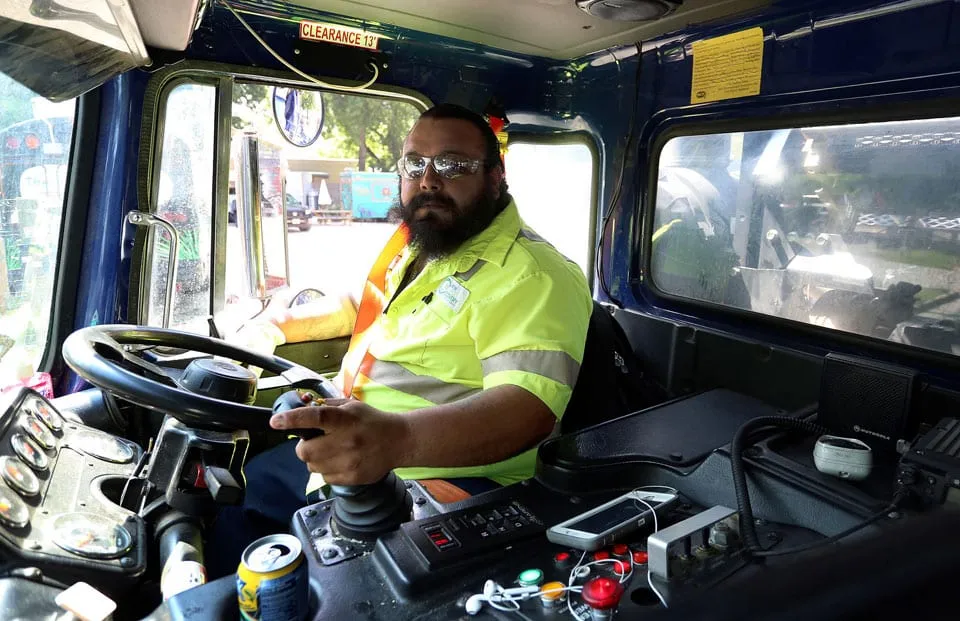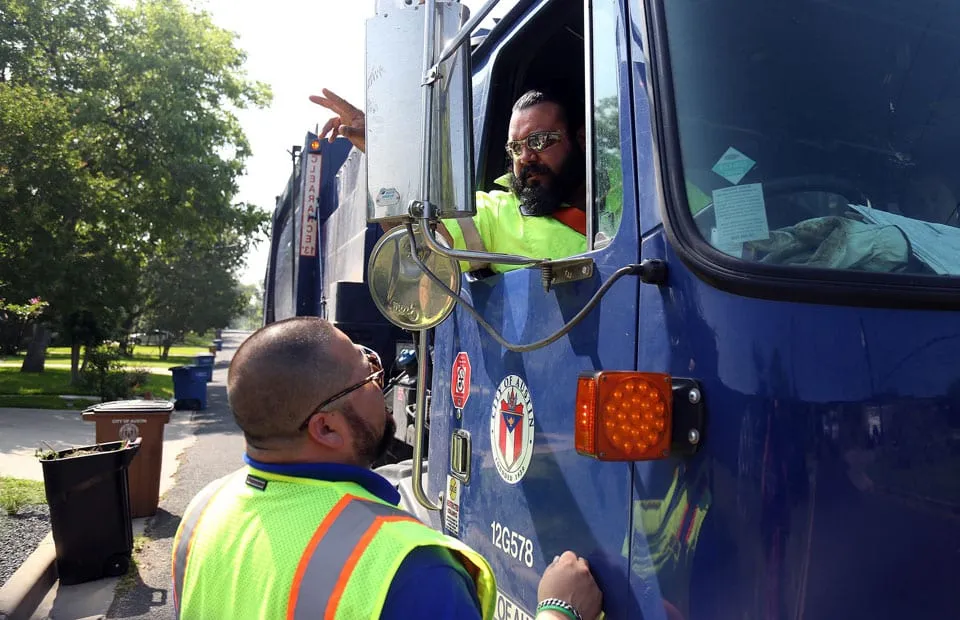Balcones celebrates 25th anniversary
WHAT HAPPENS TO AUSTIN’S RECYCLING? (AND OTHER BLUE BIN QUESTIONS)

“Would you like to have a little Coke?” asks Kathy Bell Hargrave, cracking open a can of soda in her daughter’s kitchen.
Some things we do in life without giving a second thought, but when we stop to think about them we realize they raise a lot of questions.
“Every can I open, every piece of paper, everything I want to recycle it,” says Bell Hargrave.
“I put it all in a giant blue bin, but what happens to it? I don’t know.”
She is not alone in her quest for answers.
Judging from listener questions, many people think of recycling as somehow both mundane and mysterious. So, in this edition of ATXplained, we will reply to as many of your questions about recycling in Austin as we can.
And, we’ll do so by following that 12-ounce can of Coke.
FIRST STOP: THE BLUE BIN

Jacob Cervantes collects recycling for Austin Resource Recovery.
CREDIT JORGE SANHUEZA-LYON / KUT
Now, imagine you’re a humble 12-ounce aluminum can. You sit in the bin, surrounded by paper, plastic, and probably spiders. You might be here for up to two weeks. That’s how often the city picks up residential recycling. Listener Ryan Hawkins wants to know why.
“Why do they pick up trash every week and recycle every two weeks? Shouldn’t it be the opposite? It seems like a disincentive,“ he writes.
The answer is basically, yes.
“The goal is to eventually go composting organic citywide, and weekly recycling pick up,” says Memi Cardenas, a spokesperson for Austin Resource Recovery.
But, it probably won’t happen soon. While Hawkins views the current system as “a disincentive” Cardenas says people will likely need to recycle more before the city will invest in once-a-week pick-up.
“We just really need to see that citizen participation to get everything in the right bins, so that we can flip that structure,” she says.
Instead, she says the department will likely introduce curbside compost pick-up before it switches to weekly recycling. That could take years to roll out across the city. Another reason to stick to bi-weekly recycling is the cost.
People debate whether recycling or landfilling is more expensive, but adding recycling pickups without cutting elsewhere would cost more.
SECOND STOP: THE TRUCK

CREDIT JORGE SANHUEZA-LYON / KUT
When our can is picked up from the bin, it’s dumped in one of Austin’s recycling trucks and compacted with recycling from thousands of other people. Up front, truck operator Jacob Cervantes continues his route.
“If you ain’t listening to the radio you’re listening to people talk on the CB mic…” he laughs as he maneuvers his recycling truck through crowded residential streets. It’s the kind with the big claw on the side to pick up the bins. He likes the job but it can get repetitive.

CREDIT MOSE BUCHELE / KUT
“You get a little groundhog action going on. You know that movie Groundhog Day? Where he repeats the day over and over,” he laughs again, referring to the 1992 Bill Murray film.
Austin Resource Recovery drivers like Cervantes can make up to 1,000 stops in a day. So, he’s the perfect person to pick up our next question.
“What are the most common items inappropriately placed in recycling bins?” asks James Mclane.
“You want to keep out water hoses and plastic bags. Sometimes you’ll get construction debris in there which is not recyclable,” says Cervantes without missing a beat.
The reason: hoses and thin plastic bags gum up the gears in the trucks later in the process. So, when Austin banned plastic shopping bags that helped keep Cervantes on schedule, driving his haul all the way to one of two recycling facilities that have contracts with the city to receive the recycling.
THIRD STOP: THE RECYCLING CENTER

The mound of recyclable material at Balcones Resources.
CREDIT JORGE SANHUEZA-LYON / KUT
“It’s very much like an aircraft hanger. The 100,000-foot facility,” says Bob McGiveny, director of small business sustainability at Balcones Resources, describing the company’s East Austin center.
Here’s where our can along with most of Austin’s residential recycling, is dumped into a huge pile on what’s called the “tip floor.” Called that because it’s where the trucks “tip” out their contents.

CREDIT JORGE SANHUEZA-LYON / KUT
“If you look at it you can see its everyday household things,” says McGiveny.
But this is where those “things” cease to be “things”. They stop being boxes or bottles and they become commodities. The same goes for our can.
“Aluminum is almost infinitely recyclable,” he says.
“And the raw material is bauxite. So, this can be recycled tens of tens of hundreds of times.”

The conveyor belt at the Balcones Resources facility.
CREDIT JORGE SANHUEZA-LYON / KUT
McGiveny likens the operation at Balcones to mining, the trick is to separate out the commodities and sell them to the highest bidder. Balcones accomplishes that by running the materials through an elevated conveyor belt.
This system is what a lot of people have questions about.
“How high-tech is it?” asks Kathy Hargrave.
Some of it is very high-tech. There are spots that use infrared lights to test the density of plastics and then jets of air blow them to different piles. But other parts of the line are more old-fashioned like where lines of women sort items by hand and discard unusable things like pizza boxes.

CREDIT JORGE SANHUEZA-LYON / KUT
“How clean do our peanut butter jars really have to be?” asks Glenna Soirez. Not spotless. According to Austin Resource Recovery, a quick rinse should do the trick.
What’s the craziest thing they’ve seen on the line?
“One time we had a raccoon pass through the entire system alive,” says McGiveny.
“He was just trotting on the conveyor belt.McGiveny says they stopped the belt and the raccoon eventually jumped off and went “back about his business.”
It’s a good thing he got off before the baler.

A look at some cans after they’ve been through Balcones Resources’ “baler,” which crushes cans into massive cubes that are delivered to Austin Metal & Iron.
CREDIT MOSE BUCHELE / KUT
That’s where our can ends up, crushed with all the other cans into huge colorful three-by-four-foot cubes of aluminum.
That brings us to our last question, also from Glenna Soirez:
“Where does it all go?”
About 15 percent of the stuff tossed in blue bins ends up in a landfill. The rest of the stuff is sold, then sometimes resold. It can end up down the road or overseas. As for our can, it has one more stop here in Austin.
FOURTH STOP: AUSTIN METAL & IRON

CREDIT MOSE BUCHELE / KUT
“Being the town that we live in there’s not a lot of industry, but there’s one thing this town is good at it’s drinking a lot of cans,” says Ike Shapiro, Co-owner of Austin Metal and Iron.”You know, sodas and beer and everything. So cans are a big item for us.”
Cans from the Balcones facility are sent here, where they join other cans and are shipped out of state. Where? Shapiro says Kentucky, where they’re melted down and turned back into aluminum cans.
So next time you open a can, you know it will likely pass through these doors. In fact, it may have already.
“Would you like to have a little Coke?” asks Kathy Bell Hargrave, cracking open a can of soda in her daughter’s kitchen.


